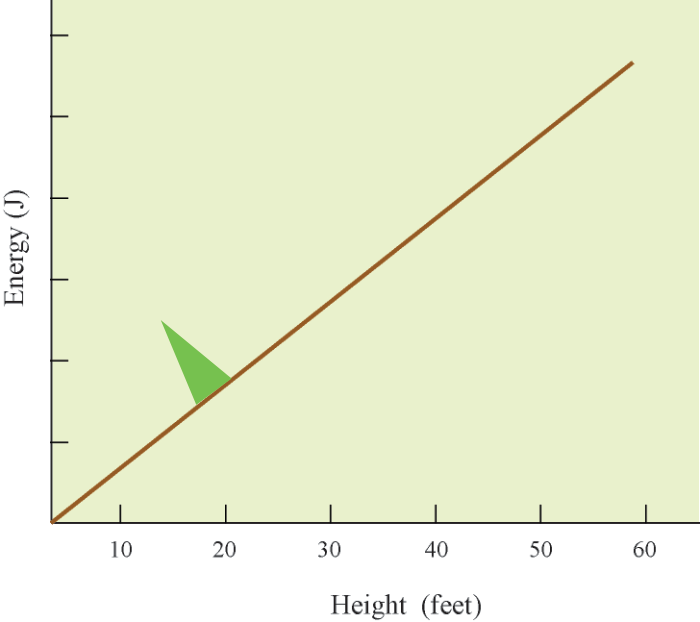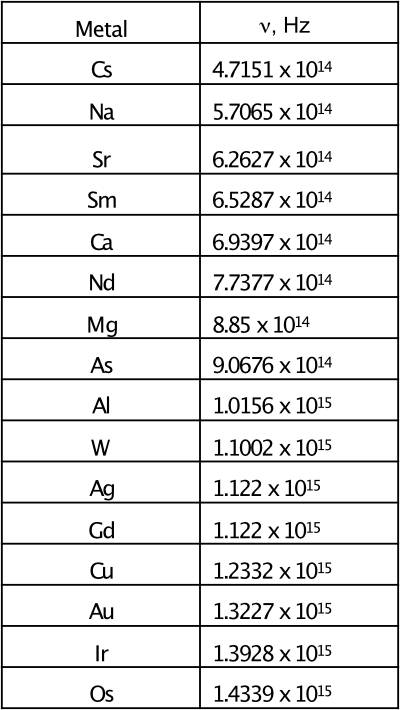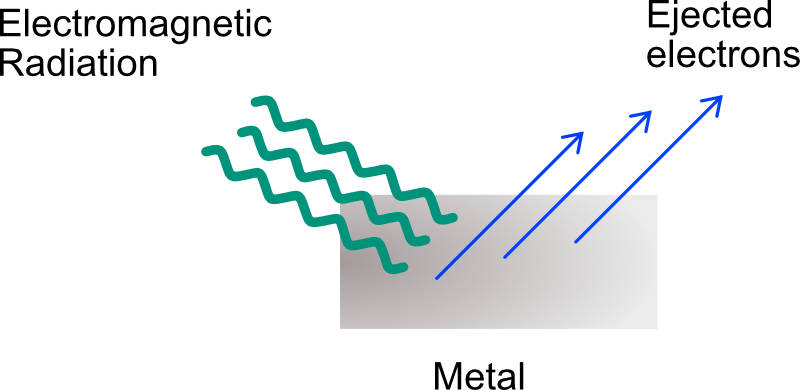The wave model of light does not explain several other observed phenomena: 1) the emission of light from hot objects (blackbody radiation), 2) the emission of electrons from the surface of a metal when it is struck with electromagnetic radiation (the photoelectric effect), and 3) the emission of light from excited gas atoms (emission spectra). We will discuss blackbody radiation and the photoelectric effect below. Emission spectra will be discussed in the next study guide.
Blackbody Radiation
When a solid is heated, it will emit radiation. We refer to this as blackbody radiation because the solids appear black before they are heated. For example, when grilling foods, we use charcoal. Once the charcoal is lit, it will smolder and turn red (T ≅ 1000 K) . A heating element on an electric stove will glow orange (T ≅ 1500 K), and the tungsten filament in a light bulb will glow white when hooked up to a power source (T ≅ 2000 K). The color and intensity, λν, of the light changes with temperature. The average kinetic energy is proportional to the temperature in Kelvin. Recall, that red light has a lower temperature than orange light, and white light has a higher temperature than orange light. Max Planck (1858 – 1947) explained that a glowing hot object could only absorb or emit certain quantities of light.
where ν is the frequency of light and h is Planck’s constant is is equal to 6.626 x 10-34 J⋅s.
The energy of an atom is quantized and not continuous. The change in the energy of an atom occurs when the atom absorbs or emits one or more packets or definite amounts of energy. The packet of energy is known as a quantum. The atom can only emit or absorb energy in whole number multiples of hν. The plural of quantum is quanta. If for example, an atom absorbs 4hν we say that 4 quanta of energy has been absorbed. Planck’s work on quantization of energy was awarded the Nobel Prize in 1918.
To understand the difference between continuous and quantized energy see the following figures. In the first figure we have a weight being pushed up a ramp. The potential energies continously increase as the weight is pushed up the ramp.
In the following figure the energy of the atom is quantized. It can have a certain amount of energy but nothing in between. It is similar to climbing stairs. Your feet only touch the stairs but do not touch between the stairs.
The Photoelectric Effect
When the surface of a metal is irradiated with radiant energy of a certain frequency, electrons are emitted from the surface of the metal. This is called the photoelectric effect. Each metal has its own threshhold frequency. The threshhold frequency is the minimum frequency of light that can be used to eject electrons from the metal’s surface. Frequencies that are equal to or higher than the threshold frequency will cause the electrons to eject. Frequencies lower than the threshhold frequency will not eject electrons from the surface of the metal. Metals have different threshold frequencies as seen in the table below. Each metal has a work function, Φ, which is the amount of energy required for the electrons to overcome the attractive forces with units of kJ/mol. Albert Einstein (1879 – 1955) expanded Planck’s theory of quantization to explain the photoelectric effect.
Einstein postulated the beam of electromagnetic radiation used to irradiate the metal surface behaved as a stream of particles called photons. The energy of a photon is equal to Planck’s constant multiplied by the frequency of light.
We can rewrite the equation to for wavelength. Recall, the frequency is equal to the speed of light, c, divided by wavelength.
One photon of blue light with a frequency of 6.66 x 1014 s-1 and a wavelength of 450 nm has an energy of:
The energy for one mole of photons with a frequency of 6.66 x 1014 s-1 is calculated by multiplying the energy of one photon by Avogadros number, NA.
Let’s say we want to calculate the minimum wavelength, nm, of light required to eject an electron from potassium metal. The work function, Φ, for potassium is 220.8 kJ/mol. This means that it will take 220.8 kJ of energy to remove 1 mole of electrons from the surface of 1 mole of potassium. First we calculate the amount of energy for one photon.
Next, solve E = hc/λ for λ.
The 541 nm, green light, of light would correspond to a threshold frequency of 5.54 x 1014 s-1. A frequency equal to or higher than the threshold frequency will eject electrons from the surface of potassium metal. A frequency lower than 5.54 x 1014 s-1 would not eject electrons. The intensity of a beam of light corresponds to the number of photons. No matter how many photons strike the metal, if the frequency is not equal to or greater than the threshold frequency, electrons will not be ejected. When a photon hits the metal, the energy, hν, of the photon is taken up by the electron. At that point, the photon stops to exist as a particle because it is absorbed.
The equation, E = hν, displays the wave-particle duality of light. The energy, E, is the photon or particle, and ν is the frequency of the wave. Both the wave and particle behavior of light is needed to describe electromagnetic radiation.
In summary, electromagnetic radiation is quantized. The energy can only be changed by the absorption or emission of a photon. The energy of the photon must equal the change in energy, Efinal – Einitial. Electromagnetic radiation has both wave and particle properties known as the wave-particle duality of light.
Worksheet: Wavelength, Frequency, and Energy
Watch the following video up to 32:27 minutes for a discussion on particle properties of light.
Exercises
Exercise 1. An X-ray has a wavelength of 2.64 nm. What is the energy of one photon?
Check Solution/Answer to Exercise 1
Exercise 2. What is the energy of the following photons in kJ/mol?
b) ν = 3.24 x 107 s-1
c) λ = 4.67 x 10-6 m
Check Solution/Answer to Exercise 2
Exercise 3. What frequency of light is needed to eject electrons from a silver solid? The work function for silver is 436 kJ/mol.
Check Solution/Answer to Exercise 3
Exercise 4. Sunburn can be caused by exposure to UV light that is about 326 nm.
b) What is the energy of 3.5 moles of these photons?
c) How many photons are in a 1.25 mJ burst of this radiation?
Check Solution/Answer to Exercise 4
Exercise 5. A laser emits a wavelength of 944 nm. The total energy measured by the detector is 0.48 J over a 29.5 second time period. How many photons per second are being emitted by the laser?
Check Solution/Answer to Exercise 5
Back to Electronic Structure of Atoms
Back to General Chemistry 1 Study Guides
Back to Home Page




